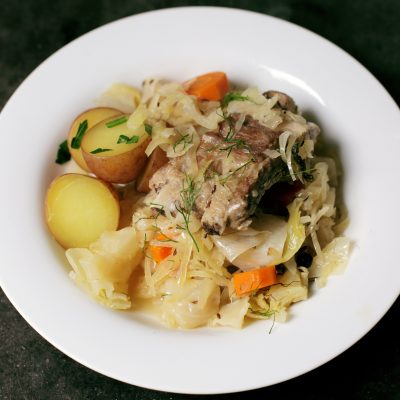The Art of Fermentation
Freshly fermented sauerkraut is a nutrient-dense, crunchier, tangier, more delicious version of the mushy kind you find in the grocery store. All it takes is the right equipment (gotta love the old school ceramic fermenting crocks), a couple ingredients and a little patience. This recipe comes from my right-hand lady, Dusti… check out her in-laws’ family cookbook below, it’s a classic.
Kugler Family Sauerkraut
Ingredients
- 5 pounds cabbage
- 3 tablespoons kosher salt
Instructions
Remove the outer leaves and center stalk from the cabbage, saving the leaves for use later in the process. Chop or shred the cabbage.
Place one layer of shredded cabbage into a ceramic fermenting crock, add some of the salt and press down firmly, until juice from the cabbage begins to release. Repeat this process of layering cabbage and salt, and then pressing, until the crock is filled to about 4/5 full.
Take two of the large outer cabbage leaves and lay them over the shredded cabbage. Next, place two weighing stones into the crock, pressing them down so that the juice begins to rise. There should be about an inch of liquid covering the stones (you may need to add boiled and cooled salt water until the stones are submerged). Place the lid on the crock and fill the surrounding channel with water to create an airtight seal.
Leave the crock at room temperature for about three days. You may hear some gurgling noises, that’s a sign the fermentation process has started. Next, move the crock to a cool place in your home.
After two weeks, check the brine level and skim off any scum that’s floated to the top (don’t be alarmed, scum is a normal part of the process!). Close the crock and refill the channel with water, again for an airtight seal. Your sauerkraut should be ready in 4 to 6 weeks.







